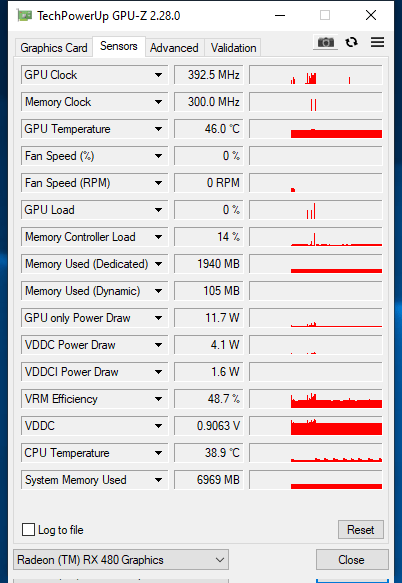- AMD Community
- Communities
- General Discussions
- General Discussions
- Re: AMD Explains Why 110-Degree Operating Temps Ar...
General Discussions
- Subscribe to RSS Feed
- Mark Topic as New
- Mark Topic as Read
- Float this Topic for Current User
- Bookmark
- Subscribe
- Mute
- Printer Friendly Page
- Mark as New
- Bookmark
- Subscribe
- Mute
- Subscribe to RSS Feed
- Permalink
- Report Inappropriate Content
AMD Explains Why 110-Degree Operating Temps Are 'in Spec' for RX 5700
posted this Tom's Hardware Article in a couple of Threads due to Users complaining about how hot the RX5700 runs:AMD Explains Why 110-Degree Operating Temps Are 'in Spec' for RX 5700 | Tom's Hardware
AMD Explains Why 110-Degree Operating Temps Are 'in Spec' for RX 5700
By Nathaniel Mott August 13, 2019
AMD said that it previously relied on "a single sensor that was placed in the vicinity of the legacy thermal diode" to measure a GPU's core temperature. That changed with the release of the AMD Radeon VII in February. The graphics card has "enhanced thermal monitoring," according to AMD, and laid the foundation for the RX 5700's "extensive network of thermal sensors distributed across the entire GPU die." Where once there was one sensor, now there are many.
The company said its previous GPUs were "often leaving significant thermal headroom – and resulting performance – on the table" by adjusting their operation based on a single measurement. These additional sensors are supposed to help RX 5700 graphics cards balance operating temperatures and performance. (Kind of like checking a hunk of meat's temperature in multiple spots to allow it to be cooked as fast as possible without any burning.)
Relying on numerous thermal sensors will become more important as companies rely on ever-smaller manufacturing processes. Those smaller nodes lead to greater thermal density, which in turn makes hotspots more common. Basing performance on the average temperature of the die, like AMD did before it introduced the Radeon VII and RX 5700, would force the GPUs to squander their potential. There's where more precise measurements come in.
AMD explained:
"Instead of setting a conservative, ‘worst case’ throttling temperature for the entire die, the Radeon RX 5700 series GPUs will continue to opportunistically and aggressively ramp clocks until any one of the many available sensors hits the ‘hotspot’ or ‘Junction’ temperature of 110 degrees Celsius. Operating at up to 110C Junction Temperature during typical gaming usage is expected and within spec. This enables the Radeon RX 5700 series GPUs to offer much higher performance and clocks out of the box, while maintaining acoustic and reliability targets."
That won't stop the company's add-in board partners from introducing cooling systems powerful enough to keep junction temperatures below triple digits. Sapphire did just that with the Pulse Radeon RX 5700 XT we reviewed yesterday, actually, and we sincerely doubt it will be the only one. But at least the company made an effort to explain why temperatures high enough to boil water are considered "in spec" for its latest GPUs.
- Mark as New
- Bookmark
- Subscribe
- Mute
- Subscribe to RSS Feed
- Permalink
- Report Inappropriate Content
My Sapphire Nitro+ RX 480 OC 8GB has a hard time getting above 75C when gaming.
I suspect that blower fan is hard pressed compared to the heat pipes and dual fan design that EVGA and Sapphire both use. The cooler card makes them survive till they are very obsolete.
My card may not be the latest model but it still packs a fair bit of action.

I would have liked more thermal sensors on the card like EVGA offers so if there is a problem it can be fixed before it festers away.
- Mark as New
- Bookmark
- Subscribe
- Mute
- Subscribe to RSS Feed
- Permalink
- Report Inappropriate Content
The RX 480 isn't measuring Junction Temperature., but instead is providing an Avg. Temperature across Multiple Sensors equally placed around the Die.
It really isn't unusual for most Microchips to be operating at 95 - 110c at the Hottest Parts., while the Avg. for the whole Die is sitting at 70 - 85c.
With this said., my Reference RX 5700 XT (with Blower Cooler) rarely hits a Junction Temp above 92c.
Silicon Quality, Case Cooling, Ambient and Location can all play a big role here... as can the Quality of the Carbon Sheet used in lieu of Thermal Paste.
If for example the sheet is a few nm thinner than it should be for good contact., well that's going to have a noticeable effect; which is why it's a little baffling that Thermal Paste wasn't used.
When I do maintenance, it's one of the first things I plan to do is replace the Carbon Sheet with Thermal Paste, like Kryonaut.. as that can have quite a noticeable impact on Junction and Avg. Temperatures.